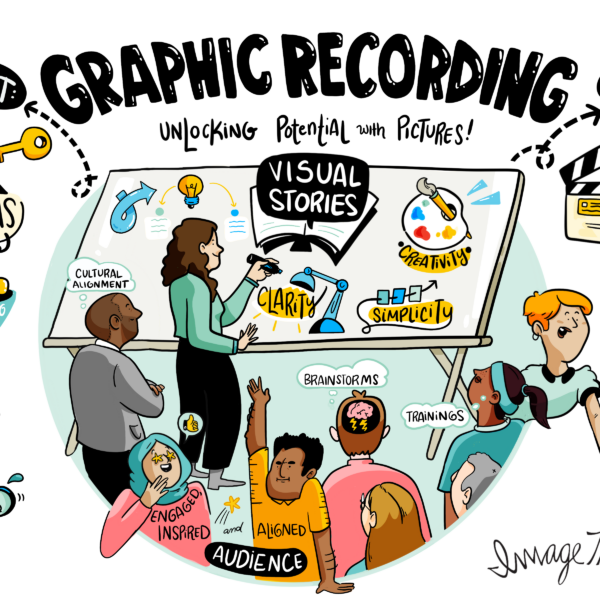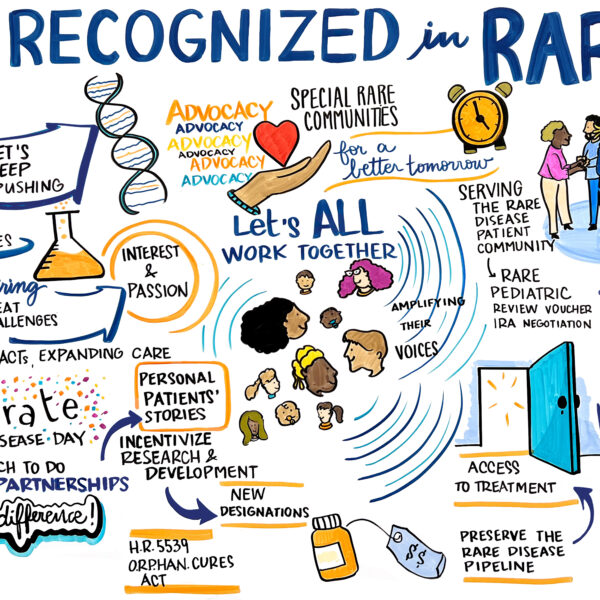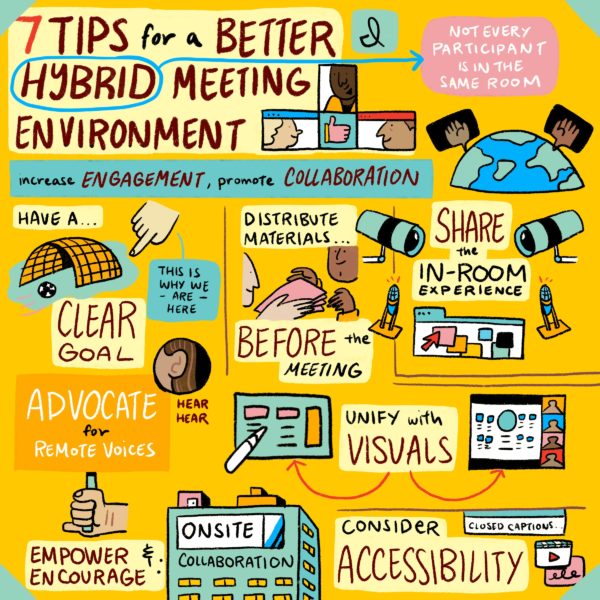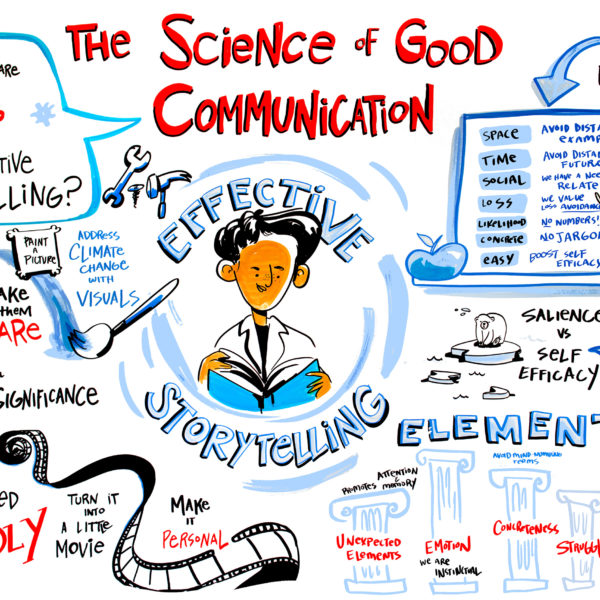The Productivity Pipeline: Word ➡️ Picture ➡️ Action
Sam Horvath: I want to shift gears and move on to another topic that we had some questions about here. It’s sticking with the theme of impact, right? And visuals contributing to a bigger impact.
Sam Horvath: I want to explore what we’ve kind of dubbed in ImageThink’s marketing as the productivity pipeline: word to picture to action.
Sam Horvath: I speak about this a lot, whenever I’m trying to scope engagements with our clients. And you know, something I hear a lot is that people have lots of meetings, and there’s big investment in new programs or a new product or a new vertical or you know, they’re launching and there’s all these great ideas that come out of things, and then those ideas, they die on the vine. They don’t go anywhere. Nothing ever happens.
Sam Horvath: And there’s just too much day-to-day work that actually gets in the way.
How do visuals create action?
Sam Horvath: Nora, as a small business owner – there’s the working in versus working on the business component, right? And it’s sort of true of, anytime you’re trying to lift or launch a new product or program so. A lot of times we’ll we share that ImageThink itself started as a drawing on the back of a napkin.
Sam Horvath: Maybe you can speak a bit to how incorporating visuals, drawing, and mapping things out can help visually connect and take the abstract, the ideas, these great brainstorms you have, and turn them into action – actually get boots on the ground, things moving.

A brainstorming scenario
Nora Herting: There’s a lot there so.
Sam Horvath: Long preamble, long question. I’ll work on that for next time.
Nora Herting: OK – so do we want to start with like a scenario – like a brainstorming scenario, right? There’s a lot of ways brainstorming has come to disappoint people.
Nora Herting: There’s the: There’s one voice in the room. Nothing new is said, all of that. That sounds like a different question altogether that we can talk about.
Nora Herting: But let’s say, you know, it’s productive in the sense that its really exciting, people are bought in, people are putting ideas out there, and it moves really fast, and then it’s maybe a portion of the day, and you move on. A lot of times, this might be in a strategy or team planning [meeting].
Nora Herting: And then, like you said, the meeting’s over and we’re back to the next day.
Challenges associated with brainstorming
Nora Herting: So, in a typical situation, is there someone who’s taken notes? Can you read your colleagues’ handwriting on the whiteboard? Was it all done in like a dried out green marker? Was there someone who is the note taker and you’re waiting for them to send that out to everybody else or call through a million sticky post it notes that aren’t that sticky and have falling all over the place. Right?
Nora Herting: So, part of it is just the logistical problem of that. Getting synthesized and put out there. And also organizing the madness.
How visuals address brainstorming challenges
Nora Herting: So, in the session where an ImageThinker is in one of these sessions, their brain is brain is doing that for you, right? They’re synthesizing, they’re grouping in themes, and then hopefully, if the group is able to align around ones that they were excited about, that is also documented in some way. And it’s sent out as a picture, that people can look at. It’s there, and it’s visual, and everyone sees what was recorded.
Nora Herting: So, there’s also an accountability element where it’s like, “Yes, this was what we all decided.” This was put to paper. Then, we’ve already just talked about the memorability of that happening for everyone in the room – being already imprinted in their mind. Now, you have something that you can carry forward, out of that, and it can be a storytelling piece as well.
Getting buy in through visual storytelling
Nora Herting: So, in a lot of these sessions, it’s not necessarily just the people in the room that are going to be responsible for either deciding those ideas are going to happen or die, but also who’s going to execute it – it’s usually other people, or people beyond them.
Nora Herting: Not only do they have to make sure that they’re carrying it forward, but they also have to socialize all that information, align people around what came out of that session, and then motivate them to do that. Having the visual aspect, the visual documentation, now helps them as a vehicle to move that momentum forward.
You can’t move to action without buy in
Sam Horvath: That’s great, and I think that can work too in both directions. Sometimes we have it where it’s like a team might have a team offsite and the artifact – the visual notes that come out of that meeting can kind of serve as again – I like that term, like a storytelling vehicle, for leadership to say, “Here’s what we accomplished. Here’s what we think, and these are our recommendations,” right?
Sam Horvath: And it can also work more downstream, where it’s like maybe leadership had a meeting and decided on some major directional decisions for the organization, whether that’s something entirely new and transformational or whether it’s solidifying an existing strategy.
Sam Horvath: But in either case, you can’t enact an idea without buy in, and a huge part of getting buy in is how well you can tell the story, right? And how well you can kind of sell the idea. So, it’s a great tool, that kind of extends the value of it.
Leveraging visuals to socialize an idea
Nora Herting: Absolutely. And that is also why, as part of our process in the ImageThink Method within our own way of supporting clients, we have a Reflection Call after a session. A lot of the time when I have that Reflection Call besides getting to hear – which I love – how thrilled they are with the ImageThink team in every capacity, which is great for everyone. But also, a good portion is to talk about how you are using these digital versions, these image boards, these digital artifacts.
Nora Herting: And it depends on what kind of project it is, but that’s where we talk about – this is now a socialization tool. This is a storytelling tool. This is the way that you can then use this as a bridge to all the other people in the organization that you need to communicate to or possibly enlist in the details of the session who weren’t in the session.
How ImageThink clients use their visuals to drive action
Nora Herting: And I just had a call with the client – an amazing client. She’s the Chief Creative Officer of an awesome brand, and she was saying, “This went to every regional division across the globe, and I’ve spoken to it. It’s now in our communication pieces.”
Nora Herting: You know, I was really impressed. She really understood, because she’s a visual thinker too, and already had four different ways that this is helping her – as someone who’s new in the role – really talk about the creative part of this major strategy that they have onn a global level.
Nora Herting: That is the power and the potential it has, and that’s why I have these Reflection Calls with clients to really help them think through: This is a tool now for you. How are you going to really lean on it to help tell your story and have the impact that you want?
Quantifying the value of visuals
Sam Horvath: That raises a good point, and I don’t know, Nora, that there’s a firm answer on this question that’s coming. But it does beg the question, or makes it a challenge to quantify the value, right? Like, there’s obviously, people recognize, there’s a value of having someone in the room.
Sam Horvath: There’s a level of engagement and attentiveness and retention. There’s that in the room value and there’s of course, the physical asset that you get – a physical and digital asset that you get out of it, this image, right?
Sam Horvath: But to try to sort of quantify the – for lack of a better word – the ROI, the return on your investment for bringing in a graphic recorder right across the live in the room impact, and the product that is the output of it and then some of these, kind of again downstream benefits that you see in the storytelling and buy in.
Sam Horvath: I don’t know if you have further thoughts, I just know it’s something that we’ve been exploring; how we think about and talk about the overall ROI of investing in visual thinking and graphic recording and the concepts of visual leadership that you espouse.
Visuals drive action during and after an engagement
Nora Herting: Oh, I just had AI just had a call with a professor at a university around doing like an actual method study around this, start to finish, not just for ourselves, but really for the industry.
Nora Herting: Like you said, there’s multiple components. We were talking about, there’s the value in the room, which I think about is like the process component of what we do: there’s mirror neurons, there’s adding the creativity, there’s bringing everyone on the same page, accelerating the decision making in the session, And the magic that happens, the way it elevates the session itself.
Nora Herting: And then there’s also the impact of what we just were talking about moving that, taking that to move people to action for organizational change and whatever capacity that is.
Nora Herting: It’s sort of twofold, and it can be, I guess an incredible accelerant in both capacities.
Why it’s easier to communicate value in other industries
Sam Horvath: Yeah, I would love to – I hope we can partner on that because I would love – I’m always sort of speaking to all these values and it’s the just the nature of where our specific kind of service and product falls within our clients’ needs. It’s usually not right at the end process where you immediately see the revenue impact the next day for the client. You know, like “Oh we brought in the graphic recorder and sales were up 20% or something you know?
Sam Horvath: It makes it harder to have statistics that some people, when you’re in I don’t know, SaaS, sales, or if you’re selling cars, and you can talk about like statistical metrics of why your service or product is so valuable. I think a study like that would be – I’d absolutely love to participate, and I’d love to read the analysis. So, I think we should do it.
Nora Herting: Yeah, I think so too.
Outro
Sam Horvath: So, with that, I’ll take a pass; you guys all heard my perfect intro, I will now do a perfect outro, where I’ll say, thanks for tuning in, however you’re listening or watching this, and giving us and ImageThink your attention and your time. Thank you, Nora for your time and thoughtfulness, and for answering some of these questions we’re getting.
Sam Horvath: We’re committing to doing this more regularly. We’re going to be doing these again, over the sort of foreseeable future.
Ask us your question
Sam Horvath: You can e-mail info@imagethink.net with your questions that you’d like answered. You can find answers to more questions on the blog as well as our past episodes and guests from the previous incarnation of Ask the Expert!
Sam Horvath: And you can also reply, subscribe, like, share – whatever platform you’re encountering this on. Do the thing below that says you like it, and you want more of it and share it with others.
Sam Horvath: Until next time, I’ve been Sam Horvath, Chief Revenue Officer, ImageThink.
Nora Herting: I’m Nora Herting, Founder and CEO of ImageThink
Sam Horvath: And this has been ImageThink’s Ask the Expert! with Nora Herting.




